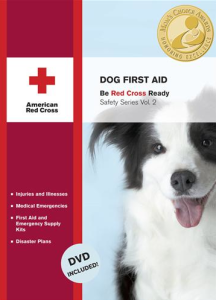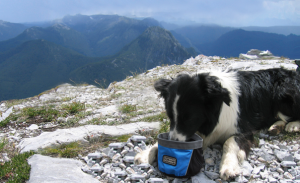10 Tips for Camping with your Dog

Ahh! …The thrill of the great outdoors, hiking trails, fresh air, and your four legged buddy alongside you for the adventure. Camping is an American outdoor pastime and owners across the nation have been inviting their canine best friend along for the ride.
In order to make your camping experience as enjoyable as possible, here are ten tips to keep in mind:
1. Always pre-plan your adventure. Know where you will be staying. Some camping grounds, RV parks, or other locations do not allow all types of dogs. Make sure you know that your camping destination will allow your particular breed of dog on the premises.
2. Make sure your dog is fully current on vaccinations, worming, and flea and tick preventative. Know what types of problems occur in the areas you will be visiting. Some parts of the country have greater needs for certain types of vaccinations than others or have different types of parasites and diseases.
3. Create a canine first aid kit to go along with yours. Accidents happen, so be prepared. You can purchase pre-made kits or find ideas for what to include in yours. Some suggestions of items to include: sterile saline solution for washing out eyes, gauze, anti-diarrhea medication, Benadryl for allergic reactions, anti-bacterial ointment, muzzle, blood clotting or styptic powder for abrasions or cuts, tweezers, bandages, etc. The Red Cross has created a book for pet owners and handlers that explains how to react in an emergency as well as ideas for a first aid kit. The book is titled: Be Red Cross Ready Safety Series Vol. 2: Dog First Aid

4. Have current information on an ID tag on your dog’s collar as well as current information on a micro-chip. Consider also adding a second ID tag with temporary info, like your cell phone number, that indicates you are camping and how to reach you in the event your dog is lost in the new area.
5. Carry your dog’s medication and copies of his medical records with you. In the event of an emergency, you will want to be able to provide this information. Know where the nearest vet is to the area you are camping in.
6. Bring plenty of your dog’s regular food as well as water. Ideally, some water from home is best to avoid intestinal upset or diarrhea, but ice cubes placed in new water will also help ease the transition.

7. Take extra precautions with your dog in new surroundings. Don’t walk him without a leash or allow him to run around the campground. Step-up his training regimen prior to camping excursions to ensure he knows commands like Come and Leave It exceptionally well with distractions.
8. Carry plenty of disposable plastic baggies to clean up after your dog. Never leave dog stools in wildlife areas. One, it pollutes the camping area, and two, it disturbs the wildlife. Properly dispose of the sacks in the trash and don’t leave them in the wilderness.
9. Don’t leave your dog’s food lying around the camp area. This will encourage the area’s wildlife to come in close to campers. While it might just be an opossum or raccoon, this habit could be dangerous in bear country.
10. Don’t leave your dog unsupervised at night outside the tent or other provisions. Your dog might prove to be too tempting for a passing predator like a coyote, bear, or mountain lion. Carry compressed air, pepper spray, or citronella spray with you in the event that you need something to quickly startle a wild animal away from you or your dog.
With some pre-planning, extra precautions, and keeping your dog’s manners and training up to speed, camping can be a wonderful endeavor that both owner and dog can enjoy.
As an Amazon Associate we earn from qualifying purchases.
